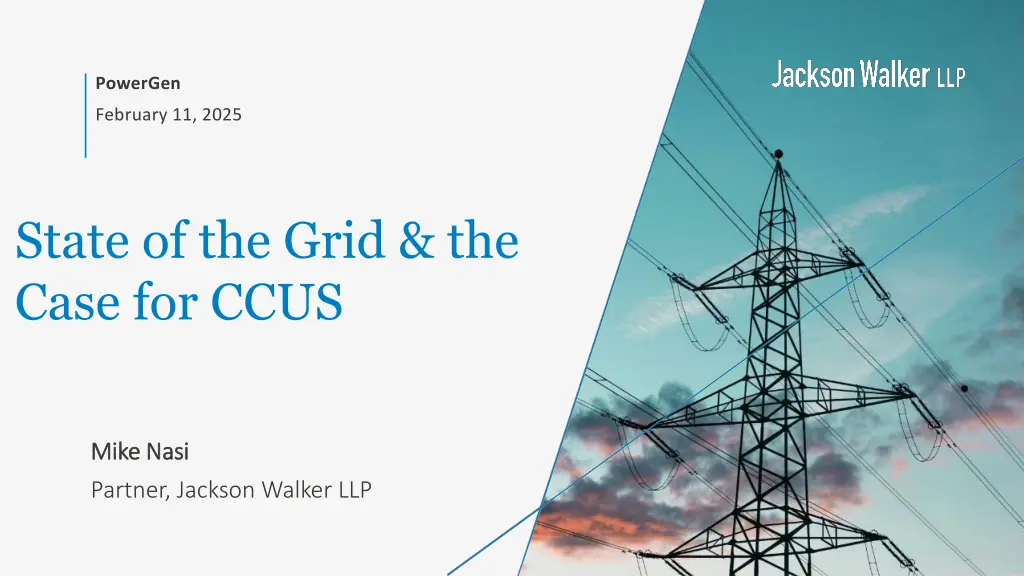
State of the Grid & the Case for CCUS Amid Regulatory Challenges
Discover the challenges facing the national grid as regulatory changes accelerate the retirement of coal plants, limit natural gas generation, and raise reliability concerns. Explore the implications of EPA regulations, grid load forecasts, joint ISO/RTO amicus briefs, and more.
Download Presentation

Please find below an Image/Link to download the presentation.
The content on the website is provided AS IS for your information and personal use only. It may not be sold, licensed, or shared on other websites without obtaining consent from the author. If you encounter any issues during the download, it is possible that the publisher has removed the file from their server.
You are allowed to download the files provided on this website for personal or commercial use, subject to the condition that they are used lawfully. All files are the property of their respective owners.
The content on the website is provided AS IS for your information and personal use only. It may not be sold, licensed, or shared on other websites without obtaining consent from the author.
E N D
Presentation Transcript
PowerGen February 11, 2025 State of the Grid & the Case for CCUS Mike Nasi Mike Nasi Partner, Jackson Walker LLP 1
Thenations largest regional grid operators have made crystal clear that the Environmental Protection Agency power-plant regulations, which have now been finalized, will make this already dire situation much worse by forcibly accelerating the retirement of the vast majority of the remaining coal fleet and making it extremely difficult, if not virtually impossible, to build the new combined-cycle natural gas generation units that will be essential as baseload generation resources to meet the rising demand for power. [ ] US House Committee on Energy& Commerce (July 24, 2024) 2
National Grid Reliability & National Grid Reliability & Resilience Warnings Resilience Warnings Source: https://www.nerc.com/pa/RAPA/ra/Reliability%20Assessments%20DL/NERC_Long%20Term%20Reliability%20Assess
Between 2022-24: Grid planners almost tripled 5- year load forecast (from 23 to 67GW) (& doubled that number in the last 6 months) 4
Unprecedented Joint ISO/RTO Amicus Brief on EPA Carbon Rule Background: Background: On Aug. 13, 2024, MISO, PJM, SPP, and ERCOT filed a joint amicus brief raising reliability concerns with the EPA Carbon Rule. The brief argued that EPA failed to adopt the mechanisms the Joint ISO/RTO proposed during the comment period. CCS as CCS as BSER BSER: : The brief stops short of saying CCS with 90% capture is not BSER but argues that EPA s standards are based on overly ambitious and adequately supported assumptions as to target dates for commercialization of CCS. The brief goes on to assert the implausibility of CCS as a viable option for mitigating CO2 emissions. EPA s obligation to consider reliability: EPA s obligation to consider reliability:The Clean Air Act s requirement to consider energy requirements must be interpreted to require explicit consideration of the Final Rule s impact on the larger energy grid. Failure to consider reliability: Failure to consider reliability: EPA has not adequately analyzed the energy requirements of the system. [B]y its own admission, EPA did not analyze the reliability implications to the grid, stating EPA does not conduct operational reliability studies. EPA s emergency safety valves : EPA s emergency safety valves : Amici shouldn t have to wait until there is a real-time emergency; they should be able to take proactive measures to protect reliability. 5
EPAs indefensible accreditations for intermittent resources EPA model assumes solar panels generate during evening hours! 6
Lessons from Winter Storm Uri (Feb. 9-19, 2021) SPP MISO ERCOT 100% 100% 100% 1.3% 3.8% 6.6% 8.8% 8.8% 12.0% 90% 90% 90% 29.0% 24.8% 80% 80% 80% 26.8% 35.8% 70% 70% 70% 42.0% 60% 60% 60% 59.7% 50% 50% 50% 38.9% 51.0% 40% 40% 40% 47.9% 30% 30% 30% 46.2% 30.0% 20% 20% 20% 18.2% 24.3% 13.4% 10% 10% 10% 14.0% 9.1% 8.0% 5.7% 4.9% 2.2% 0% 0% 0% Installed Capacity Generation During Uri Installed Capacity Generation During Uri Installed Capacity Generation During Uri Nuclear Coal Gas Wind Nuclear Coal Gas Wind Nuclear Coal Gas Wind Solar SOURCE: U.S. Energy Information Administration, Hourly Grid Monitor Dashboard Averaged Over Full Duration of Winter Storm Uri (2/9/21-2/19/21) 7
EPA ASSUMED THE COAL FLEET IS GOING AWAY But coal retirements are being delayed due to grid concerns (>29 GWs) Plant State Planned Revised Capacity Plant State Planned Revised Capacity White Bluff (Entergy) AR 2024 2028 1650 MW Roxboro Units 3&4 NC 2027 2034 745 MW AR 2025 2030 1650 MW Independence (Entergy) North Omaha (OPPD) NE 2023 2026 645 MW Indian River (NRG Energy) DE 2022 2026 410 MW Coal Creek (acquired by Rainbow Energy) ND 2021 No Set Date 1150 MW Bowen 1 & 2 (Georgia Power) GA 2027 No Set Date 1440 MW Winyah 1 & 2 (Santee Cooper) SC 2027 2030 570 MW Scherer 3 (Georgia Power) GA 2027 2035 860 MW Fayette 1 (City of Austin) TX 2022 2028 570 MW Baldwin (Vistra) IL 2025 2027 1185 MW Shafer Power Station (NIPSCO) IN 2023 2025 1940 MW Hunter (Rocky Mtn. Power) UT 2032 2045 1577 MW Rockport 2 (AEP) IN 2022 2028 1300 MW Hunnington (Rocky Mtn. Power) UT 2032 2046 1037 MW Michigan City (NIPSCO) IN 2027 2028 540 MW Clover (Dominion Energy) VA 2025 2045 848 MW F.B. Culley (Vectran) IN 2024 2026 775 MW Merom (acquired by Hallador Power Company) IN 2023 No Set Date 980 MW Edgewater (Alliant Energy) WI 2023 2025 380 MW Lawrence Unit 4 & 5 (Evergy) KS 2023 2028 486 MW Columbia (Alliant Energy) WI 2024 June 2026 1100 MW Ghent 2 (Louisville Gas & Electric/Kentucky Util.) KY 2028 No Set Date 1200 MW Brown 3 (Louisville Gas & Electric/Kentucky Util.) KY 2028 No Set Date 557 MW Oak Creek 5 & 6 (WEC Energy Group) WI 2022 2024 525 MW Sherburne 1 (Xcel Energy) MN 2026 2030 680 MW Sherburne 2 (Xcel Energy) MN 2023 2026 680 MW Oak Creek 7 & 8 (WEC Energy Group) WI 2023 2025 310 MW Sioux 1 & 2 MO 2028 2033 1100 MW Lakefront (Monitowac Municipal) WI 2024 No Set Date 69 MW GG Allen (Duke) NC 2023 2024 435 MW Pleasants (First Energy) WV 2018 No Set Date 1288 MW Mayo (Duke) NC 2028 2031 382 MW 8 Roxboro Unit 1 &2 NC 2028 2029 1068 MW Jim Bridger 3 & 4 WY 2022 2037 2441 MW
Comparing CCUS Environmental Stewardship Attributes RENEWABLES/STORAGE KEY CONSIDERATIONS CCUS FOR COAL/GAS Power Density of Solar 4-10 W/m2 Power Density of Wind 0.5-01.5 W/m2 Power Density of Wood 0.5-01.5 W/m2 Power Density of Coal 100-1,000 W/m2 Power Density of Gas 200-2,000 W/m2 Land Use / Power Density (per Vaclav Smil) Bird Strikes Habitat Destruction Lithium/Cobalt Mining for Batteries Rare Earths for Turbines & Solar U.S. Air is safe for vast majority of country impacted by power generation Long-established mine reclamation rules protect water & preserve land stewardship Non-GHG Externalities Backup Power Emissions Life-cycle GHGs from construction & land use associated with renewable developments Missed R&D opportunity No backup power required - 24/7/365 U.S. R&D makes global deployment much more realistic which will be MUCH more impactful on CO2 levels than renewables GHG Externalities Dependence on Minerals & Products Not Mined/Made in US & subject to tariff risks Permanently dependent on subsidies/mandates Domestic fuels (coal & gas) + export commodity (enhanced oil & technology) Initial subsidy will be phased out with time Geopolitical Security & Trade Low Capacity Factors & Accreditation Massive Transmission Additions Needed Weather-Dependent = Resilience Penalty to Grid Consequence of weather-dependent wind & solar is that the grid has become much less reliable & resilient (we are betting on weather) High Capacity Factors & Accreditation No New Transmission Needed High Reliability & Resilience Value to Grid Flexibility of carbon capture machine slip stream management - capable of load following & demand response. True & Total Consumer Cost Focus Must be on Levelized Cost of Dispatchable & Delivered Energy 9
WAVE OF LOW-CARBON REGULATORY & MARKET RISKS GLOBAL FINANCE & CORPORATE ESG SUBSIDIES & OTHER MARKET DISTORTIONS FEDERAL REGULATORY World Bank, IFC, & Development Funds Not Financing Fossil Fuel Projects Overseas Low Carbon Commitments by Major Banks & Customers Direct Tax Subsidies for Renewable Energy (RE) EPA 111 Carbon Rules BLM Coal Leasing Indirect RE Subsidies (e.g., transmission) Customer State Portfolio Standards Some threats can be managed at the courthouse & ballot box, but MANY risks to fossil fuel markets can only be hedged with CCUS technology deployed here and abroad 10
The Energy Starved Worlds Top Priority is Eradicating Energy Poverty & Our Global Rivals Will be Glad to Displace Us As Their Energy & Technology Provider 47% of the world uses less power per year than the average large U.S. refrigerator (1,200 kWh/y) Global avg (3,500 kWh/y) would have to quadruple to be at U.S. levels (which are still rising with demand) Per Capita Electricity Use By Nation (2023) 63% of the world is energy starved (<4,000 kWh/y) 11






















